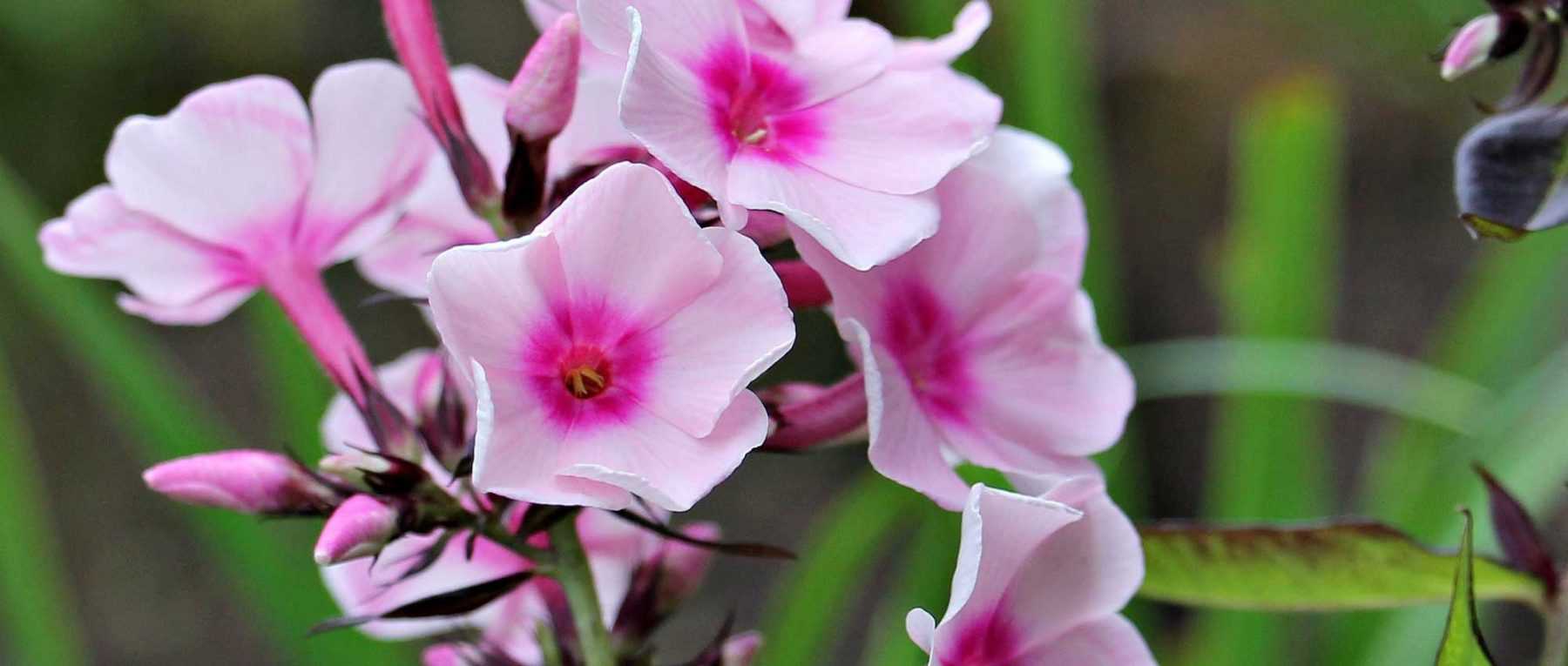
Phlox: Planting, Growing and Care
Contents
Phlox in a nutshell
- Phlox offer abundant flowering, often in soft hues, sometimes vibrant
- During bloom time, some varieties become literally covered in flowers… sometimes forming wide colourful carpets!
- Phlox can be either tall with an upright habit, or ground-covering with a cushion-like form
- Depending on the variety, they can be planted in flower beds, on stone walls, or in rock gardens…
Our Expert's Word
Phlox are perennial or annual plants with abundant star-shaped blooms. Their form can vary greatly depending on the species: dwarf moss phlox have a creeping habit (Phlox subulata, P. douglasii) and sometimes form beautiful ground covers, while taller varieties have an upright habit (Phlox paniculata) and are better suited to flower beds. Phlox produce a multitude of star-shaped flowers in spring or summer, often in shades of pink, blue, white, red or mauve… Their hues can be soft and pastel or quite vibrant. They are generally perennial, though some species are annual, such as Drummond’s phlox, Phlox drummondii. The most popular are likely the panicled phlox, which come in many horticultural varieties.
These are fairly hardy and easy-to-grow plants. They should be planted in spring, in full sun or partial shade. For maintenance, panicled phlox will appreciate regular watering in summer and should be cut back in late autumn. It’s also advisable to deadhead spent flowers, as this prolongs flowering. They can be propagated by division or seed… In fact, it’s recommended to divide them roughly every four years to rejuvenate the clumps, which can otherwise become exhausted.
Many varieties offer pleasantly fragrant blooms. And the flowers of upright phlox (particularly panicled phlox) are perfect for bouquets!
Description and botany
Botanical data
- Latin name Phlox sp.
- Family Polemionaceae
- Common name Phlox
- Flowering depending on variety, between April and October
- Height from 10 cm to 1.20 m, sometimes up to 1.50 m
- Exposure sun or partial shade
- Soil type moist, well-drained, rich
- Hardiness -15 to -20 °C
Phlox are herbaceous plants, annual or perennial, originating almost exclusively from North America. They comprise just over 80 species. Most cultivated species, including Garden Phlox (Phlox paniculata), are native to the United States. There is also one species found in Siberia! In gardens, the most common are Phlox paniculata and Phlox subulata. These are easy-to-grow, hardy plants as they come from temperate regions. There are now thought to be over 800 horticultural varieties! The vast majority are perennial, with the exception of Phlox drummondii, which is an annual.
In the wild, different phlox species are found in varied environments: sometimes in rocky areas (for creeping phlox), near watercourses (for panicled phlox), and many species grow in woodland. This explains their different uses in the garden: Phlox subulata will thrive in rockeries, while others will prefer moister, deeper and more fertile soils…
Etymologically, the name phlox comes from the Greek and means “flame”, due to the bright colour of some species. Phlox belong to the Polemoniaceae family, a relatively small family of just over 400 species, which includes cultivated plants such as Jacob’s Ladder (Polemonium), with its beautiful blue flowers and finely divided foliage, but also the Cobaea, a climbing plant.
In terms of general plant form, phlox have either an upright habit, like Phlox paniculata, or a creeping habit, like Phlox subulata. The latter can therefore be used as ground cover! They sometimes form wide colourful carpets… The height of phlox is therefore very variable: between 10-20 cm for the lowest, creeping varieties… And up to 1.50 metres for upright phlox (Phlox paniculata)! There are also intermediate varieties, such as Phlox carolina ‘Bill Baker’, which forms clumps 45-50 cm tall. The cushion-like habit and fine foliage of Phlox subulata earns them the common name of Moss Phlox!
The use of phlox will therefore differ depending on their form: compact varieties will find their place at the front of borders or in rockeries, while upright varieties will integrate into the middle or back of a border or mixed-border, behind lower-growing plants.
Depending on the species, flowering occurs between April and October. Garden Phlox flowers in summer, from July until September-October, while Phlox subulata flowers in spring, in April and May. It lasts much less time.
Phlox then offer a very generous flowering! Creeping varieties are literally covered with flowers, hiding their foliage, creating wide pink or mauve carpets… As for the flowers of Phlox paniculata, they are grouped in terminal, rounded inflorescences, carried at the end of upright stems. Phlox flowering is generally very dense!
Phlox often flower in soft, pastel shades: white, pale pink, mauve or blue. But sometimes they are much more pronounced: bright red, vivid pink, violet… The Phlox ‘Starfire’, with its red flowers, is among the most intense varieties! Flowers can also be bicoloured. The centre of the flower (the eye) is often lighter or darker than the petal lobes. Sometimes the flowers appear striped, with coloured rays emanating from the centre, as in Phlox paniculata ‘Peppermint Twist’ or Phlox maculata ‘Natasha’. The variety ‘Sherbet Blend’ is very surprising with its anise green and pale pink flowers! A truly unusual colour mix… Phlox divaricata, on the other hand, offers a superb blue hue.
The flowers of most species measure between 1 and 3 centimetres in diameter. The corolla consists of five more or less narrow petals, fused into an elongated tube. They give (especially when narrow) the flower a star-shaped appearance. The Phlox drummondii from the ‘Popstars’ series offer impressive flowers in terms of shape, with petals ending in long, fine points! The petal lobe is sometimes notched or bilabiate (Phlox bifida…). The corolla tube (petals) is surrounded by five fused sepals, and contains five stamens. The Phlox ‘Blind Lion’ stands out for its extremely different flowering from other varieties! In fact, it doesn’t really look like a phlox: it bears very dark foliage and panicles composed of purple-black flower buds that do not open.
Many varieties have the advantage of offering fragrant flowers, particularly among Phlox paniculata and divaricata. This is what gives the poetic name to the variety ‘Clouds of Perfume’.


Phlox flowering: Phlox paniculata ‘Peppermint Twist’, Phlox subulata (photo Anneli Salo), and Phlox drummondii ‘Popstars F1 Blue’
Phlox foliage is fairly ordinary. The leaves are entire, lanceolate in shape for Garden Phlox, and linear, much finer, in Phlox subulata. They are generally opposite, placed in pairs on the stems, but those at the top are sometimes alternate. Leaves vary greatly in size, from those of tall Garden Phlox which can reach up to 15 centimetres in length, to those of creeping varieties, such as Moss Phlox, which do not exceed 2 centimetres long! The leaves are often ciliate on the edge of the blade. They are relatively uniform and are distributed along the entire stem.
Leaves are mostly green, but there are also some variegated varieties, such as ‘Becky Towe’: its leaves are green in the centre, and irregularly margined with yellow. Combined with its pink flowering, this makes this variety very bright and colourful! In Garden Phlox, the basal foliage is often unsightly, which is why it is often recommended to place other low-growing perennials in front to hide it.


Phlox foliage: Phlox paniculata ‘Bright Eyes’, Phlox subulata ‘Scarlet Flame’ and Phlox paniculata ‘Becky Towe’
The leaves of Phlox paniculata are generally deciduous: the above-ground parts of the plant (stems and leaves) dry out in autumn and disappear, to regrow in spring… But the foliage of Moss Phlox (Phlox subulata) is evergreen!
After flowering, phlox produce capsules that open with three valves when ripe to release brown, oval seeds. The fruit is rather insignificant and has little decorative interest.
Read also
Aconite: Planting, Care and DividingThe main varieties
These are mainly Phlox paniculata and maculata. They are ideal for planting in flower beds, behind lower-growing plants.

Phlox paniculata Blue Paradise
- Flowering time August, September
- Height at maturity 90 cm

Phlox paniculata Fujiyama
- Flowering time August to October
- Height at maturity 90 cm
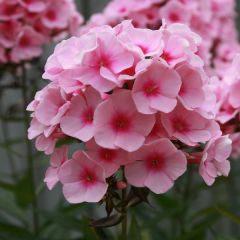
Phlox paniculata Rosa Pastel
- Flowering time August, September
- Height at maturity 75 cm

Phlox paniculata David
- Flowering time August, September
- Height at maturity 1,10 m

Phlox paniculata Bright Eyes
- Flowering time August to October
- Height at maturity 60 cm

Phlox paniculata Orange Perfection
- Flowering time August to October
- Height at maturity 80 cm

Phlox maculata Natasha
- Flowering time August, September
- Height at maturity 90 cm
These include Phlox subulata, bifida and douglasii. They form wide ground covers or compact cushions, smothered in spring blooms! Perfect for rock gardens, slopes or walls. They thrive in stony, well-drained soil and tolerate drought better than tall phlox.

Phlox subulata White Delight
- Flowering time May to July
- Height at maturity 15 cm

Phlox subulata Candy Stripes
- Flowering time May to July
- Height at maturity 10 cm

Phlox bifida 'Minima Colvin'
- Flowering time June, July
- Height at maturity 15 cm
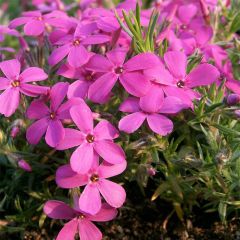
Phlox douglasii Waterloo
- Flowering time June, July
- Height at maturity 20 cm
These are Drummond’s phlox, Phlox drummondii, sown directly in spring.

Phlox drummondii Moody Blues Seeds - Drummonds phlox
- Flowering time July to September
- Height at maturity 25 cm

Phlox drummondii Sugar Stars
- Flowering time August to October
- Height at maturity 50 cm
Discover other Phlox
Planting perennial phlox
Where to plant?
Most phlox thrive in sunny or lightly shaded positions. Sunny exposures will ensure abundant flowering, often with a stronger fragrance! However, their ideal location also depends on your geographical area: if you live in the northern half of France, plant them in full sun, but if you’re in the Mediterranean region, they’ll appreciate light shade during the hottest afternoon hours. Some species are better suited to shady planting, such as in woodland settings, like Phlox stolonifera.
Phlox dislike chalky soils, preferring slightly acidic or neutral conditions. They enjoy fresh, well-draining substrates where water doesn’t stagnate in winter. Avoid confined environments too, as these could encourage fungal diseases.
Paniculate phlox appreciate humus-rich, fertile soils that are both light and deep. They’ll thrive in ground that remains cool in summer! They’re particularly well-suited to border planting.
Low-growing, mat-forming phlox like Phlox subulata or douglasii prefer to be planted in dry, rocky, very well-drained soil. They’re perfect for rockeries and dry stone walls! They also tolerate sea spray well.
When to plant phlox?
Plant phlox in your garden preferably in early spring, around April, though autumn planting is also possible.
How to plant?
We recommend spacing plants 30-40 cm apart.
- Prepare the ground by digging a planting hole about twice the size of the root ball. Add well-rotted compost, as phlox appreciate organic-rich soil.
- Position the phlox in the planting hole.
- Backfill with soil and firm gently.
- Water thoroughly.
We suggest applying mulch to maintain soil moisture.
Continue with regular watering in the weeks following planting.
Sowing annual phlox
Unlike perennial species, annual phlox should be planted in the garden by sowing directly in the ground. This mainly concerns Phlox drummondii. It dislikes being transplanted: it’s best to sow it directly in its final position. You can do this in spring, around May.
- Prepare the seedbed: add some well-rotted compost, work the soil by breaking up large clumps and removing weeds.
- Sow the seeds.
- Cover with a thin layer of potting soil. You can lightly firm the soil.
- Water gently.
Keep the soil moist by watering regularly. When seedlings begin to grow, thin them out by removing some of the young shoots, leaving only one plant every 20 cm.
Caring for Phlox
Water your panicled phlox regularly, especially during summer… They thrive in soil that remains cool, as in nature they grow near rivers. If they suffer from drought, there’s a risk that flowering will diminish and the foliage will become unsightly. Apply mulch to help retain soil moisture. This will allow you to space out watering intervals. The Phlox subulata varieties are more drought-resistant and dislike excessive moisture.
It’s best to remove faded flowers, as this encourages new buds to form and may prolong the flowering period. The taller varieties (Phlox paniculata) may require staking.
Since phlox appreciate rich soil, we also recommend applying well-rotted compost around their base in autumn, lightly working it into the soil with a rake. This will promote abundant flowering! You can also apply organic fertiliser in spring.
Divide Phlox paniculata clumps roughly every four years to rejuvenate them. Over time, the plants become exhausted, leading to reduced flowering… This also gives you the opportunity to replant them elsewhere in your garden or share them with friends!
Tall, upright species like Phlox paniculata should be cut back after flowering. Each year in late autumn, prune the stems to 5–10 cm above ground level. You can also trim phlox during the growing season to maintain a more compact, bushy shape.
Diseases and Pests
Phlox are hardy perennials that thrive in our gardens for many years. They are quite frequently affected by powdery mildew in summer. This fungal disease, which doesn’t seriously hinder phlox cultivation, appears as a white powdery coating on the foliage. The most susceptible seem to be Phlox paniculata, while Phlox divaricata and maculata show greater resistance. But even among Phlox paniculata, some varieties fare better than others. Notable resistant cultivars include ‘David’, ‘Eva Cullum’, ‘Bright Eyes’, ‘Peppermint Twist’ and ‘Robert Poore’. To prevent powdery mildew, avoid planting too densely to ensure good air circulation, and water at the base of the plant without wetting the foliage. If the disease appears, remove affected leaves to limit its spread and treat with sulphur.
Phlox can also be affected by septoria leaf spot, which causes brown spots on leaves, and verticillium wilt, which leads to foliage wilting and plant decline. However, these two diseases are less common in phlox than powdery mildew.
They may also be attacked by nematodes (typically in summer): microscopic worms that enter stems and cause plant decline. Stems become twisted, swollen and brittle, flowering is reduced, and foliage becomes distorted. Remove affected plants to prevent nematodes spreading to healthy specimens.
Regarding other pests, phlox can be targeted by leaf miners, while slugs and snails may nibble on tender young shoots.
Propagation: sowing, cuttings
Phlox can be propagated by seed, cuttings, and division. For perennial species, we recommend division, while sowing is more suitable for annual phlox. Phlox divaricata naturally tends to layer when its stems touch the ground, and Phlox stolonifera spreads via stolons. With these two species, it is therefore easy to take cuttings to propagate the plant.
Sowing
You can collect phlox seeds to resow them in spring.
Sow annual species (notably Phlox drummondii) directly in situ, around May.
- Prepare the soil to create a fine seedbed, free of clumps, large stones, or weeds, and take the opportunity to add some compost.
- Sow by scattering the seeds on the surface.
- Cover them with a thin layer of potting soil.
- Water gently with a fine spray.
Continue to water regularly. Thin out the seedlings later.
Sow panicled phlox in March, under cover.
- Fill a pot with potting soil and lightly firm it down.
- Sow the seeds, spacing them 2–3 cm apart.
- Cover them with a thin layer of substrate.
- Firm down and water.
- Place the pot in a cold frame.
Keep the potting soil moist until germination. You can plant them out in the garden around May.


A sowing of Phlox paniculata (photo Nadiatalent), young shoots of Phlox paniculata ‘Tatjana’ (photo Bff), and Phlox paniculata ‘White Eye Flame’
Division
You can divide Phlox paniculata and maculata approximately every four years. This helps rejuvenate the clumps, making them more vigorous and floriferous. We recommend doing this in early spring (around March–April) or in autumn.
- Choose a well-established clump, several years old, and dig it up.
- Divide the rootstock into several sections, prioritising outer portions.
- Replant the divisions immediately in prepared soil. You can return one division to the original spot and plant the rest elsewhere in the garden—or give them away!
- Water generously.
Cuttings
You can propagate Phlox subulata by cuttings. First, disinfect tools to avoid spreading diseases.
Phlox paniculata propagates easily from root cuttings in December.
- Prepare a tray with a mix of potting soil and sand, then moisten the substrate.
- Dig up a phlox rootstock, taking care not to damage the roots.
- Remove soil to expose a root (rinse with water if needed) and cut it into 4–5 cm segments, each with small roots. Make clean cuts.
- Place them horizontally in the tray.
- Cover with a few centimetres of substrate.
- Shelter the cuttings from frost.
Keep the substrate moist but not waterlogged. Plant the cuttings in April.
You can also take stem cuttings in autumn after flowering:
- Take 10 cm stem segments.
- Remove lower leaves, keeping only those at the top.
- Dip the base in rooting hormone.
- Plant in a pot of pre-moistened potting soil.
- Firm the soil around it.
- Cover the pot with a plastic bag to create a humid environment.
Combining Phlox in the Garden
Garden phlox (Phlox paniculata) are perfect for flower beds or mixed borders, alongside other summer-flowering perennials. As they are quite tall, we recommend planting them behind lower-growing plants… Especially since the basal foliage of garden phlox isn’t particularly attractive! The ideal solution is to conceal the base by placing shorter flowering plants in front, such as hardy geraniums. For a delicate, romantic atmosphere, don’t hesitate to pair them with roses, sages or Calamintha grandiflora! Phlox also combine beautifully with salvias, whose flowers are often blue or mauve… You’ll easily find varieties in matching tones! They also work well alongside Polemoniums, maiden pinks (Dianthus deltoides), ageratums or bellflowers…


Planting idea: Rosa ‘Gertrude Jekyll’, Calamintha grandiflora, Salvia nemorosa and Phlox cardina ‘Bill Baker’ (photo Friedrich Strauss – MAP)
As phlox often display pastel-coloured blooms, they pair well with other pink or white flowers. The more vibrant varieties can be used in colourful flower beds or to brighten up a dull border! Create striking contrasts by combining purple phlox with orange flowers – two colours that enhance each other for an intense, dynamic effect!
Don’t hesitate to mix different phlox varieties to extend the flowering period!
Moss phlox (Phlox subulata) are excellent rock garden plants. You can create a dry garden on a mound, incorporating large stones and well-draining substrate. Plant moss phlox alongside Dalmatian bellflower (Campanula portenschlagiana), saxifrages, Cymbalaria muralis, Arenaria montana or Aster alpinus! Add some small geraniums like Geranium cinereum or Geranium renardii! They also combine well with the decorative foliage of Acaena!
Moss phlox can also be used to brighten up an old stone wall! Or plant them at the front of a border with well-drained soil. Take advantage of them to add colour to dry, difficult-to-plant areas of the garden. In spring, they’ll form a magnificent carpet of pink or mauve flowers!
Did you know?
- Edible flowers
The flowers of Phlox paniculata are edible: you can add them to fruit salads or use them to colour your dishes! They have a flavour that is both sweet and spicy.
- A Japanese festival to celebrate phlox blooming!
In Japan, the Fuji Shibazakura Festival takes place every year in April-May, where thousands of visitors come to admire the carpets of Phlox subulata, planted in a 2.4-hectare park with Mount Fuji as a backdrop! Around Lake Motosu, the phlox form large colourful flowerbeds in soft pink, deep pink and white tones. In Japanese, these moss phlox are called Shibazakura, which could be translated as “lawn cherry tree”, due to their ground-covering habit and abundant spring pink flowering!
Useful resources
- Discover our wide range of phlox!
- Our video advice – How to plant perennials?
- Our advice sheet on powdery mildew, a disease to which phlox are susceptible
- Our advice sheet: Phlox, which one to choose?
Frequently asked questions
-
The leaves of my phlox have white powdery-looking spots!
It is affected by powdery mildew, a fungal disease. We recommend removing and burning the affected leaves, then treating by spraying with sulphur. When watering, direct the flow at the base of the plant to avoid wetting the foliage.
-
The flowering of my phlox is becoming less abundant, less generous than before. Why?
After a few years, phlox tends to weaken. It's then time to divide it! This will help rejuvenate the clump and restore its vigour.
If it's a Phlox paniculata, the soil may be too poor. Consider adding well-rotted compost and possibly a bit of fertiliser.
- Subscribe!
- Contents
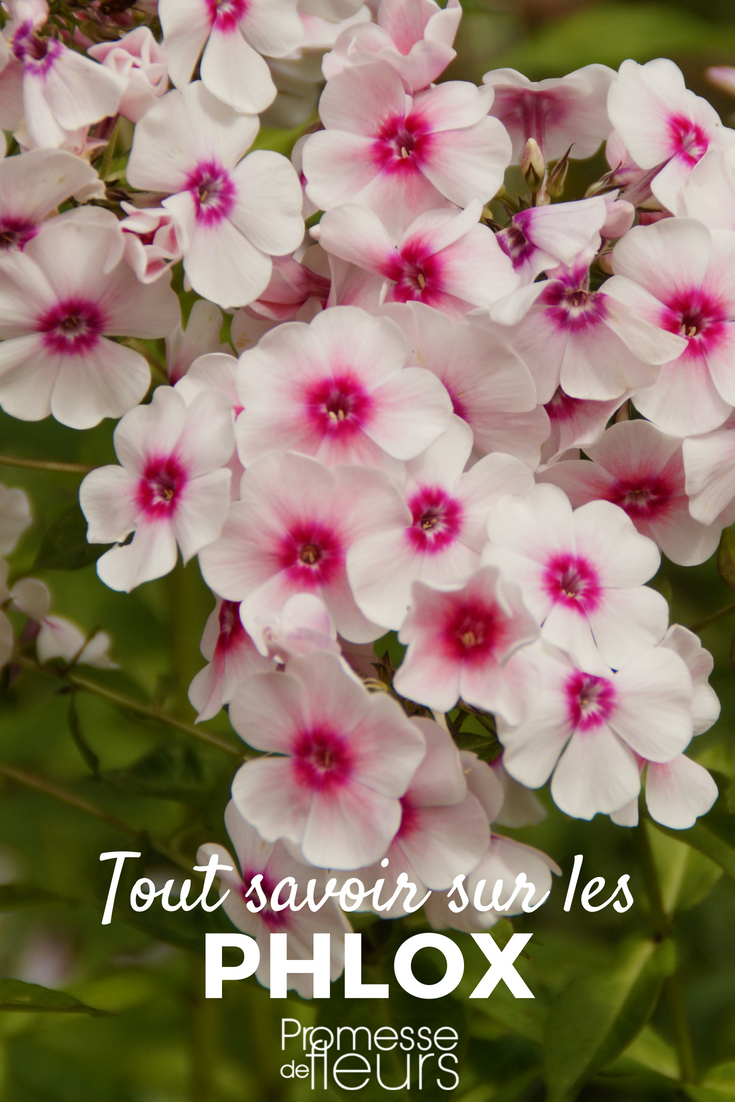


































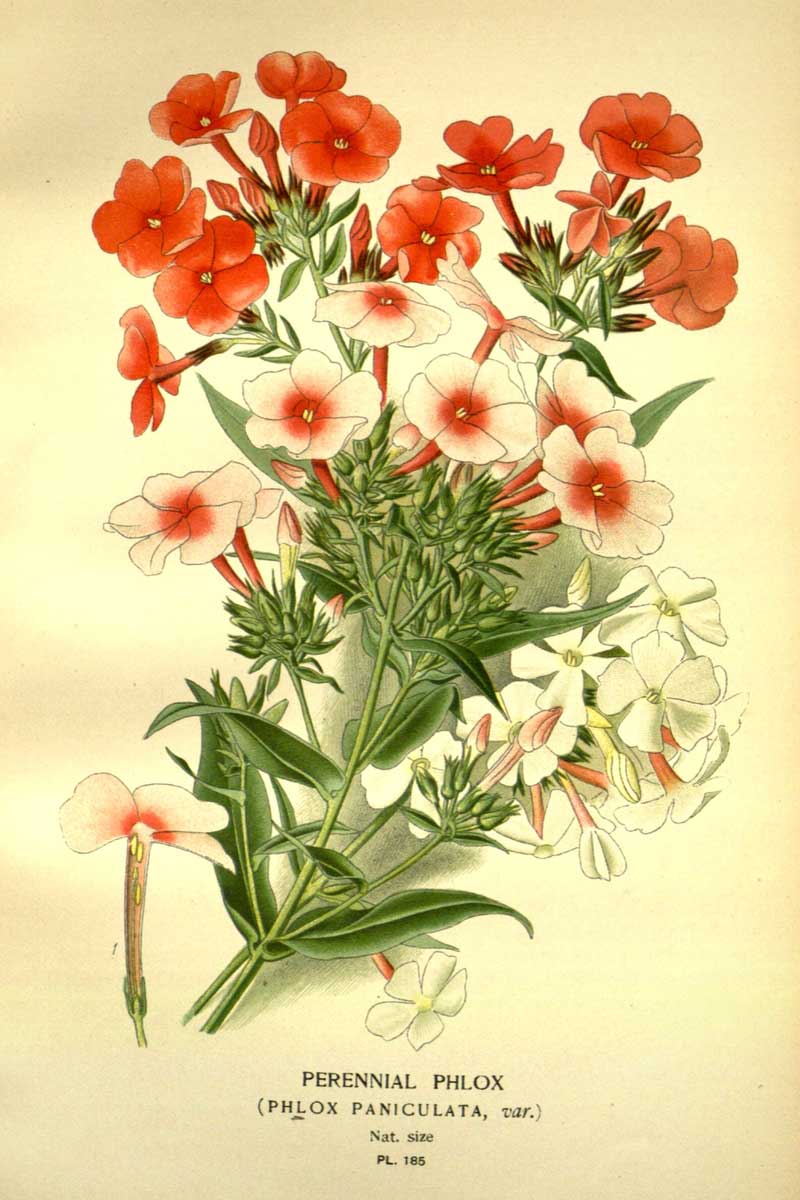
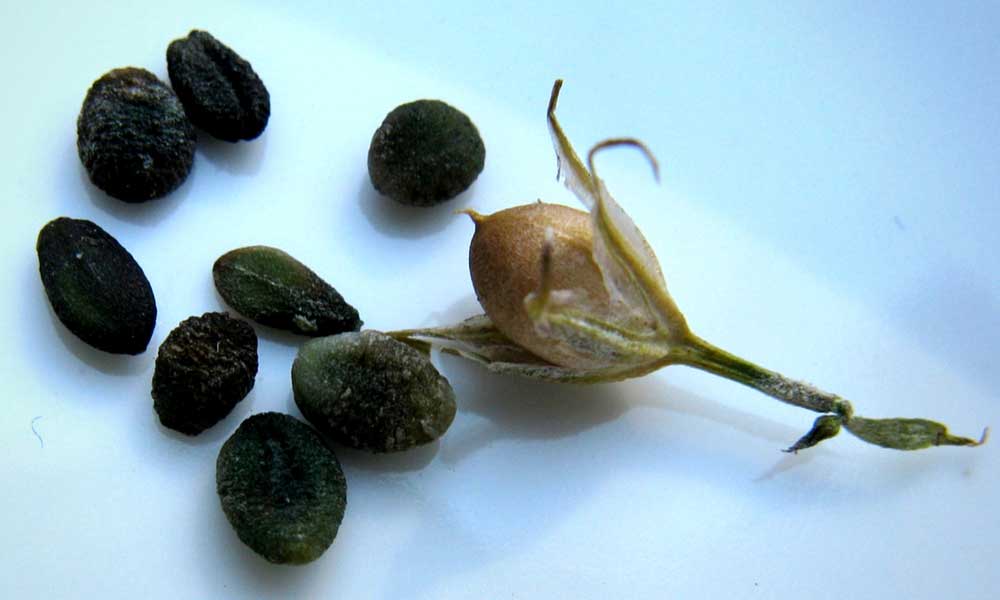

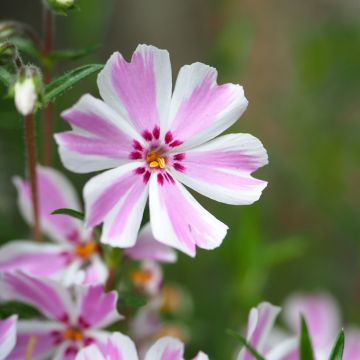

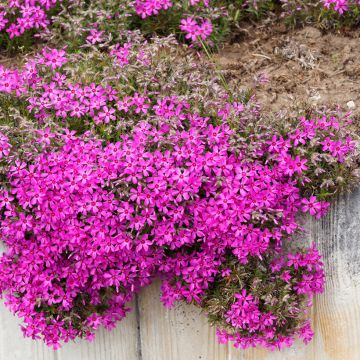

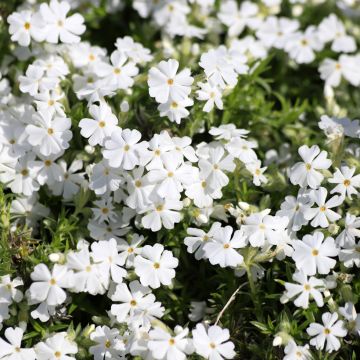

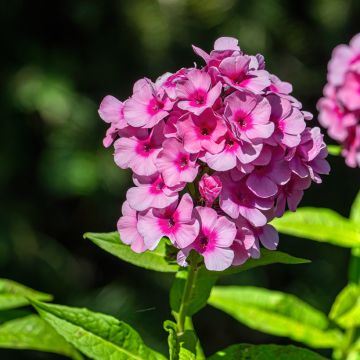



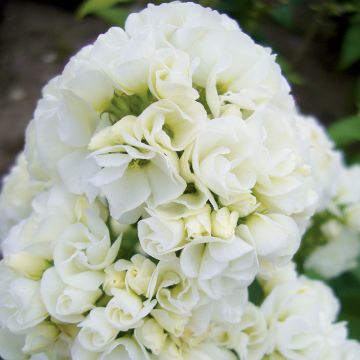
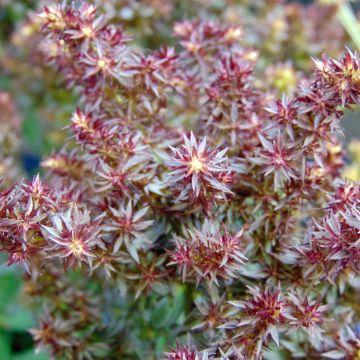



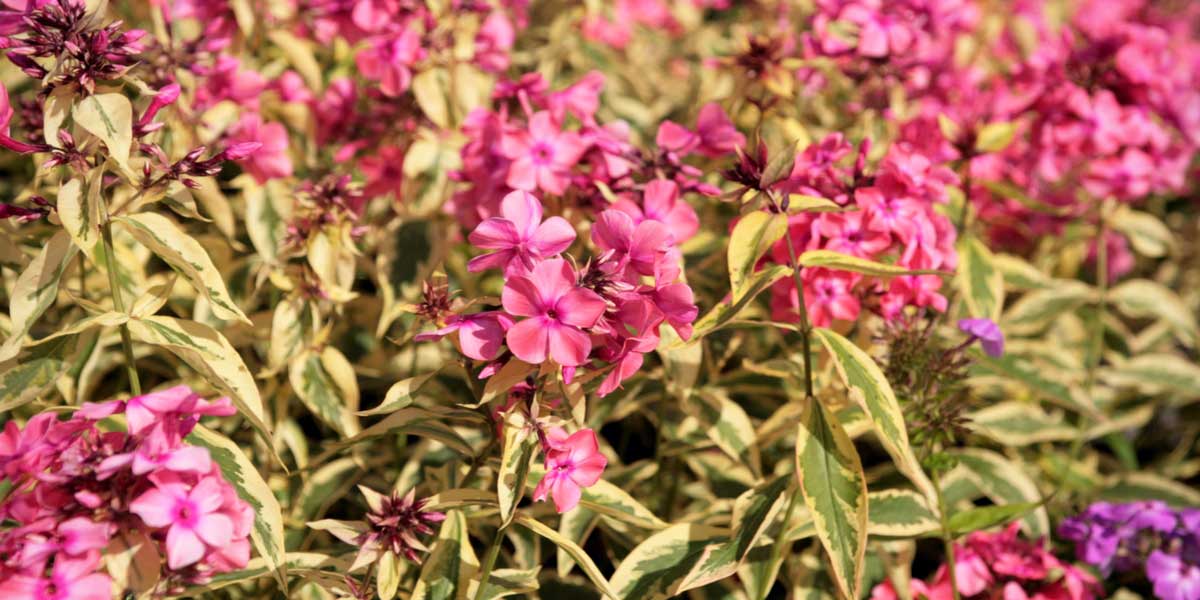

Comments